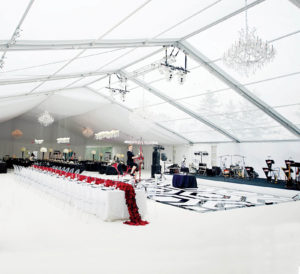
Clearspan structures open up lucrative markets for tent rental companies. With scaled-down and modular designs, even small tent rental companies can take advantage of these opportunities.
Clearspan structures offer an array of benefits for tent rental companies and their clients. One of the biggest attractions is their unobstructed interior space—there’s no need for interior support with these structures—affording more room for tables, chairs, dance floors and people. And, because there’s typically no need for exterior guy wires or ratchets, clearspans don’t present the trip-and-fall hazards of other tent styles.
There are other pluses, says Chad Struthers, vice president of tent manufacturer Warner Shelter Systems Ltd. of Calgary, Alberta, Canada. Clearspans can be decorated more easily and thoroughly than other tent styles, says Struthers, with ample opportunities for “jazzing them up” because their load ratings let them accept heavy decor and lighting. They also offer numerous hang points.
Keith Krzeminski, executive vice president of tent manufacturer Shelter Structures America Inc. of Palos Verdes Estates, Calif., agrees.
“The decor advantages of a clearspan allow for more options on the accessories, such as doors, glass, etc., as well as the ability to hang liners, lights and theatrical elements inside the tent, while still allowing for a safe environment,” he says.
Clearspans are also desirable for events when climate control is needed and when it’s important to have engineering certification and/or structures that are rated for wind and snow loads, says Jim Reyen, business director for tent manufacturer Eureka! The Tent Company, Binghamton, N.Y.
“They’ve proven effective in most reasonable weather,” Reyen says. “If you’re expecting higher wind and you want a more controlled environment, then clearspans are a logical choice, although clearspans do tend to make a lot of noise in windy conditions. This includes creaking and flexing noises that can be a distraction during some events.”
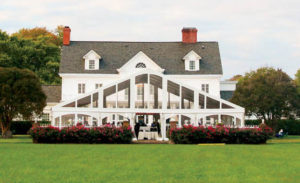
Given the advantages, investing in clearspans would seem to be an easy decision for tent rental company owners and managers. But before making the leap, decision makers need to consider other factors, including cost, market demand in the geographic area they serve, training needs for sales and installation crews and handling and care logistics.
Market demand
Creaking sounds aside, demand for these tents is strong. “They’re used for every type of event, including sporting, corporate, trade shows, exhibitions or for military, industrial and disaster-relief applications, just to name a few,” Krzeminski says. “Consequently, there’s high demand for clearspan structures in most geographic markets. Clearspans also have the advantage over pole and frame tents when it comes to longer-term applications.”
Clearspans appeal to markets where the build-out requires a high degree of safety and aesthetics, says Jeff McInnes, sales manager, East Coast, for tent manufacturer HTS-USA Clearspan Structure Systems Inc., Lauderdale By Sea, Fla. Demand is happening “across the board,” he says.
“We’re seeing a lot more marketing visionaries asking for structures that are aligned with and support and enhance their brand image,” he says. “Companies have gone crazy with branding and experiential marketing. This is a major driver in pushing forward the design future of these tents.”
Also fueling demand is that these tents meet the more stringent requirements of the 2015 International Fire Code requirements, McInnes says.
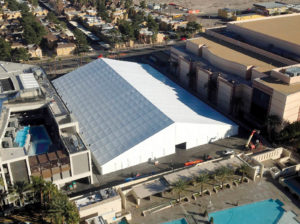
With fire marshals and code officials becoming more concerned with safety involving the use of temporary structures of all kinds, increasing demand for engineered structures is clearly the trend, says David MacArthur, national sales manager for tent manufacturer Losberger U.S. LLC, Frederick, Md. “Although weather-resistance requirements for temporary structures differ in different markets, [these] officials are now requiring more users to deploy engineered tents that meet code requirements for weather resistance,” he says. Even in snow conditions, clearspans can be engineered for long-term installations, another demand driver, MacArthur says.
Golf and country clubs have represented a growing opportunity as more of them look to clearspans for their events, Reyen says. Struthers has noticed demand coming from these venues as well. This has resulted in more exposure for these tents and greater awareness, further accelerating their popularity.
Flexible options
Because clearspan structures can be so massive, decision makers in small- to medium-sized tent rental companies may think that incorporating these structures into their inventories isn’t practical. In some cases that may be true, although not due to the size alone, because many clearspan manufacturers offer small structures.
For example, Warner offers the Tent-X-Span. Available in widths of 30 or 40 feet, it can be expanded via additional modules or decreased to accommodate any sized rental. The E!Span™ X4 or “little E!” from Eureka! is a smaller-profile engineered and wind-rated clearspan available in widths of 20, 30 and 40 feet. HTS offers the HÖCKER P-Series (modular marquee and pavilion structures) and the HTS Party Tent Series available in a variety of shapes and sizes. Both series come with accessory options, such as glass walls and double doors.
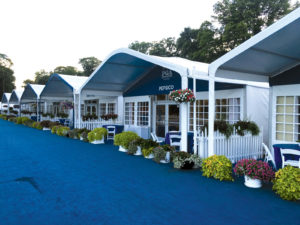
Included in Losberger’s small tent lineup are multiflex tents in widths of 3, 6, 9, 12 and up to 15 meters. Various design modules and modifications are available, such as rounded sloping ends, high-peak inserts, dormer additions and glass sidewalls with double doors. Shelter Structures offers clearspans for smaller needs too: the G Series (3 to 12 meters) and the M Series (15 to 30 meters). Both are modular, expandable, offer gable or bell ends and have snow-shedding capabilities.
The larger issues for tent rental companies are affordability and return on investment (ROI). Although the introduction of more economical options has put clearspans within the reach of renters traditionally priced out of this structure, Krzeminski says clearspans are typically more expensive for rental companies to acquire and customers to rent compared to same-build pole or frame tents.
The rental rate that companies would need to charge in order to achieve ROI within a certain number of rentals may be a hard-sell in areas that haven’t yet fully embraced clearspans, says MacArthur. This makes it imperative that rental companies fully understand their markets, potential demand for the product and whether their clients are willing to pay more before moving forward, Reyen says.
Struthers says if a rental company is situated in a fairly affluent area, or one where there are a lot of corporate events, fundraisers, tradeshows with outdoor exhibits, festivals and so on, then clearspan inventory may open up some new markets. McInnes suggests looking at the number of residential versus corporate events the rental company has, since most of the demand will come on the corporate side, although clearspans are often appropriate for high-end residential events too. He also suggests selecting a product with build-size functionality and an expandable frame system for greater flexibility.
Krzeminski recommends paying attention to the requests coming in. “If a rental company is at the point of moving into or beyond 50- and 60-foot-wide tents, it would be the time to start looking at what advantages clearspans have over traditional pole and frame tents.”
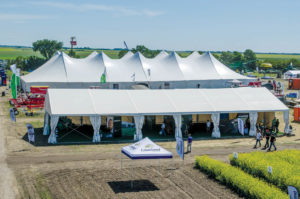
(shown here as 40-by-90-foot) can be expanded or decreased to accommodate any size of rental. Photo courtesy of Handy Special Events.
Before you leap
Even with a clear market demand, rental company owners need to consider a host of additional issues before adding clearspans to inventory. Although the installation of smaller clearspans is often equivalent in terms of time and labor to those of same-build frame and pole tents, large clearspans pose logistical challenges, Krzeminski says. Their loading and installation could require forklifts. Bigger washing machines and wash areas may become necessary. Employees will need training on selling clearspans, on their installation and dismantling (and more crews may be required for these tasks) and on maintenance and warehousing, MacArthur says.
“Transport also needs to be looked at,” he says. “Most pole and small frame tents can fit in a 20-foot box truck. More than likely, you’ll need longer trucks and/or trailers to haul your clearspan.”
Intrigued but not ready to commit? “Tent rental companies may want to start by subrenting the product and testing it in their market before fully jumping in,” Reyen says.
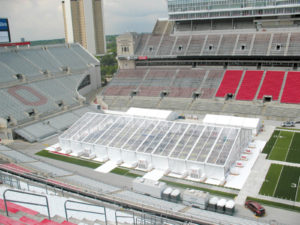
There’s no doubt that clearspan structures offer tent rental companies of all sizes the opportunity to move into high-end, lucrative markets. Clearspans are more likely to meet stringent code requirements, and they offer outstanding features for decorating. Know the demands of your market, what you need from a manufacturer and your internal capabilities, and when you are ready to make the investment, you’ll be in the clear.
Pamela Mills-Senn is a Long Beach, Calif.-based freelance writer.
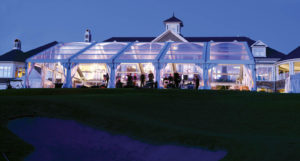
Asking the right questions can help avoid the kinds of surprises that threaten both return on investment and peace of mind. David MacArthur, national sales manager for Losberger U.S. LLC, Frederick, Md., suggests determining what inventory and parts the manufacturer has on hand and in what quantities. “Manufacturers may have bargain-basement pricing on clearspans,” he says. “But if they can’t quickly deliver new products and parts to their rental dealers, what good is the cheap price?”
Keith Krzeminski, executive vice president of Shelter Structures America Inc., Palos Verdes Estates, Calif., says that on-hand inventory is particularly important because clearspans are manufactured all over the world, with parts, pieces and fabrics made and sourced in different areas. Consequently, availability isn’t necessarily determined by the manufacturer’s location but rather by standing inventory.
MacArthur also recommends that tent rental companies consider:
- Strength of the dealer’s network. “Availability of subrentals between dealers of clearspan equipment is an important benefit since no one company’s inventory is always exactly what is needed for every event,” he says.
- Training. This includes both how much training a manufacturer offers and for whom (sales, warehousing, field installation crews, etc.).
- Price as a reflection of total value. “Top product quality has its price,” he says. “Superb user support and training also come with a price.”
It’s often instructive to talk with other tent rental companies who have worked with a specific manufacturer to glean what their experience has been, especially in the areas of product quality and customer service, which “should always be at the top of the list when choosing a vendor,” MacArthur says.
 TEXTILES.ORG
TEXTILES.ORG


